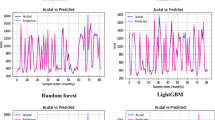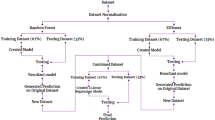Abstract
In this paper, using the Hurst exponent value H, we first show that the automotive price in Iran Khodro Company (IRAN) is predictable and therefore a good forecasting can be done using neural networks. We then introduce a new global and fast hybrid multilayer perceptron neural network (MLP-NN) in order to forecast the automotive price. In our new framework, we hybridize the genetic algorithm (GA) and least square (LS) method in order to train the connected weights of the network, which leads us to have a global and fast network. To do so, the connected weights between input and hidden layers are trained by GA and the connected weights between the hidden and output layers are trained by LS method. We finally apply our new MLP-NN to forecast the automotive price in Iran Khodro Company, which is the biggest automotive manufacturing in IRAN. The results are well promising compared with the cases when we apply the GA and LS individually. We also compare the results with the case when we employ the gradient-based optimization techniques such as Levenberg–Marquardt method as well as some heuristic algorithms such as extended tabu search algorithm instead of LS method and hybridization of MLP-LM with GA.










Similar content being viewed by others
References
Alba E, Chicano JF (2004) Training neural networks with GA hybrid algorithms. In: Deb K (ed) Proceedings of GECCO’04, Seattle, Washington, LNCS 3102, pp 852–863
Atakulerka A, Sutivany D (2007) Avoiding local minima in feed forward neural networks by simulation learning. In: Australian conference on artificial intelligence, pp 100–109
Battiti R (1992) First and second-order methods for learning: between steepest descent and Newton’s method. Neural Comput 4(2):141–166
Bouchard M (2001) Faster convergence and improved performance in least-square training of neural networks for active sound cancellation. Proc Int Conf Art Neural Netw 2130:583–592
Charalambous C (1992) Conjugate gradient algorithm for efficient training of artificial neural networks. Circuits, devices and systems. IEEE Proc 139(3):301–310
Chow TWS, Cho SY (2007) Neural networks and computing. Imperial College Press, London
Goldberg D (1988) Genetic algorithms in machine learning, optimization and search. Addison-Wesley, Longman Publishing Co., Boston
Goldberg PE (1989) Genetic algorithms on search, optimization, and machine learning. Addison, Wesley
Hagan MT, Menhaj M (1994) Training feed forward networks with the Marquardt algorithm. IEEE Trans Neural Netw 5(6):989–993
Haupt RL, Haupt SE (2004) Practical genetic algorithms. Wiley, New York
Haykin S (1994) Neural networks: a comprehensive foundation. Macmillan, New York
Hurst HE (1951) Long-term capacity storage of reservoirs. Trans Am Soc Civil Eng 116:770–799
Kim D, Kim H, Chung D (2005) A modified genetic algorithm for fast training neural networks, vol 3496. Springer, Berlin, pp 660–665
Krose B, Smagt PVD (1996) An introduction to neural networks. The University of Amsterdam
Masters T (1995) Advanced algorithms for neural networks. Wiley, New York
Mc Loone SF, Irwin GW (1997) Fast parallel off-line training of multilayer perceptrons. IEEE Trans Neural Netw 8(3):646–653
McNelis PD (2005) Neural networks in finance: gaining predictive edge in the market. Elsevier Academic Press, Burlington
Montana DJ, Davis L (1989) Training feed forward neural networks using genetic algorithms. Proc Int Joint Conf Art Intelligence, New York
Otair MA, Salameh WA (2004) An improved back-propagation neural networks using a modified non-linear function. Proceedings of the IASTED international conference, Inn Sbruck, Australian, pp 442–447
Pan S, Lai C (2006) Identification of chaotic systems by neural network with hybrid learning algorithm. Chaosm Solitons Fractals 37(1):233–244
Pasti R, De Castro L (2006) An immune and a gradient-based method to train multilayer perceptron neural networks. International joint conference on neural networks, pp 2075–2082
Peyghami MR, Khanduzi R (2011) A hybrid model based on neural network and hybrid genetic algorithm for automotive price forecasting. Int J Appl Math Comput 3(1)
Prudencio RBC, Ludermir TB (2002) Neural network hybrid learning: genetic algorithms & Levenberg-Marquardt. In: 26th annual conference of the gesellschaft for classification, Heidelberg, Berlin
Qian B, Rasheed K (2004) Hurst exponent and financial market predictability. The IASTED conference on financial engineering and applications, Palma de Mallorca, Spain
Rojas R (1996) Neural networks. Springer, Berlin
Salzano M (2005) Neural networks as tools for increasing the forecast and control of complex economic systems. Econom Complex 2(1):1–10
Sexton RS, Alidaee B, Dorsey RE, Johnson JD (1998) Global optimization for artificial neural networks: a tabu search application. Eur J Oper Res 106:570–584
Shafiabadi N, Teshnelab M, Aliyari Shooredeh M (2006) A comparison of PSO and back propagation combined with LS and RLS in identification using fuzzy neural networks. IEEE International Conference on Industrial Technology, Mumbai, India
Siddique MNH, Tokhi MO (2001) Training neural network: back propagation vs genetic algorithms. Int Joint Conf Neural Netw 4:2673–2678
Thiesing FM, Vornberger O (1997) Sales forecasting using neural networks. IEEE Proc 4:2125–2128
Wang RL, Tang Z, Cao QP (2003) An efficient approximation algorithm for finding a maximum clique using hopfield network learning. Neural Comput 15(7):1605–1619
Wilamowski BM, Iplikci S, Kaynak O, Efe MO (2001) An algorithm for fast convergence in training neural networks. Int Joint Conf Neural Netw 3:1778–1782
Yam YF, Chow TWS (1995) Accelerated training algorithm for feed forward neural networks based on least squares method. Neural Process Lett 2(4):20–25
Zhang GP (2004) Neural Networks in Business Forecasting. IRM Press (an important of Idea Group Inc)
Acknowledgments
This research was in part supported by a grant from IPM (No. 88900027) for the first author. The authors would like to thank the research council of K.N. Toosi University of Technology for supporting this research. The work also has been supported by Research and Development office of IRAN Khodro Company for the second author.
Author information
Authors and Affiliations
Corresponding author
Rights and permissions
About this article
Cite this article
Peyghami, M.R., Khanduzi, R. Predictability and forecasting automotive price based on a hybrid train algorithm of MLP neural network. Neural Comput & Applic 21, 125–132 (2012). https://doi.org/10.1007/s00521-011-0605-7
Received:
Accepted:
Published:
Issue Date:
DOI: https://doi.org/10.1007/s00521-011-0605-7




